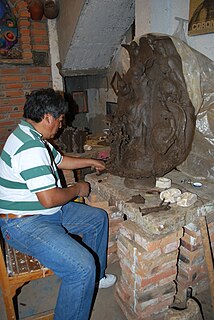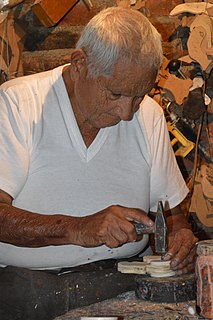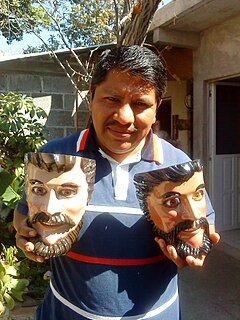Related Research Articles

Talavera pottery is a Mexican and Spanish pottery tradition from Talavera de la Reina, in Spain. The Mexican pottery is a type of majolica (faience) or tin-glazed earthenware, with a white base glaze typical of the type. It comes from the town of San Pablo del Monte and the cities of Puebla, Atlixco, Cholula, and Tecali, because of the quality of the natural clay found there and the tradition of production which goes back to the 16th century. Much of this pottery was decorated only in blue, but colors such as yellow, black, green, orange and mauve have also been used. Majolica pottery was brought to Mexico by the Spanish in the first century of the colonial period. Production of this ceramic became highly developed in Puebla because of the availability of fine clays and the demand for tiles from the newly established churches and monasteries in the area. The industry had grown sufficiently that by the mid-17th century, standards and guilds had been established which further improved the quality, leading Puebla into what is called the "golden age" of Talavera pottery. Formally, the tradition that developed there is called Talavera Poblana to distinguish it from the similarly named Talavera pottery of Spain. It is a mixture of Italian, Spanish and indigenous ceramic techniques.

Ceramics in Mexico date back thousands of years before the Pre-Columbian period, when ceramic arts and pottery crafts developed with the first advanced civilizations and cultures of Mesoamerica. With one exception, pre-Hispanic wares were not glazed, but rather burnished and painted with colored fine clay slips. The potter's wheel was unknown as well; pieces were shaped by molding, coiling and other methods.

Museo Universitario de Artes Populares María Teresa Pomar is a museum dedicated to Mexico's handcrafts and folk art tradition, called “artesanía.” It is part of the University of Colima in the city of Colima, founded by artesanía collector and promoter María Terea Pomar. It contains one of the most important collections of its type in Mexico, covering traditions from around the country as well as the artesanía and traditions of the state of Colima.

The Soteno family of Metepec is one of the main families of ceramic artisans specializing in sculptures called Trees of Life which have made the town found in the State of Mexico one of Mexico’s main ceramic centers. The Tree of Life is a complicated colorful sculpture which was developed from the creation of candlesticks. The family’s prominence began with Modesta Fernández Mata, the mother, grandmother and great-grandmother of the Soteno potters today, who began experimenting making more decorative items along with utilitarian ones. The generations after her have learned the craft and improved on it starting as children working with parents and grandparents. The two most notable members of the family are Tiburcio and Oscar, second and third generation respectively, who have won various awards and have their works in collections worldwide.

Ángel Santos Juárez is a Mexican potter known for his miniatures and decorative work, which has won various awards.

Jesús José Bernabe Campechano is a fourth generation Mexican potter who is best known keeping the disappearing ceramic form of “petatillo” alive. He has won various awards for this work including the Galardon Angel Carranza of Mexico’s National Ceramics Prize in 1989.
Adrián Luis González is a Mexican potter specializes in Trees of Life and other decorative pieces.

Zenón Martínez García was a Mexican potter from Tlaquepaque, Jalisco recognized for his figurines.

Florentino Jimón Barba is a Mexican potter based in Tonalá, Jalisco.

Nicasio Pajarito Gonzalez is a Mexican potter from Tonalá, Jalisco known for his canelo ware.
Cesar Torres Ramírez is a Mexican potter who specialized in the country Talavera pottery tradition. His work has been featured in books such as Cerámica Y Cultura: The Story of Spanish and Mexican Mayólica of the Museum of International Folk Art in New Mexico, in the Grandes Maestros de Arte Popular Mexicano as a “grand master” by the Fomento Cultural Banamex and as one of Mexico’s best artisans in a documentary on Canal Once in Mexico.

Alfonso Castillo Orta was a Mexican potter from the ceramics town of Izúcar de Matamoros, Puebla, whose work made the ceramics of this area internationally known. He was particularly known for his trees of life sculptures and received various awards for his work, including the Premio Nacional de Ciencias y Artes in 1996. He taught the craft to his wife and five children who continue to create pieces in his style in the family workshop.
Neftalí Ayungua Suárez is a Mexican potter from Patamban, Michoacán, named a “grand master” of Mexican folk art.
Celso Camacho Quiroz is a fourth-generation Mexican potter who works in Metepec, in the State of Mexico. His specialty is the making of large cooking vessels called “cazuelas,” traditionally used to cook mole and rice, but he also makes a number of other utilitarian and decorative pieces. His work has been recognized with awards such as the Gran Premio de Arte Popoular from FONART in 1999 and being named a “grand master” by the Fomento Cultural Banamex in 2003.
Miguel Chan and Roger Juárez are Mexican potters, partners in producing Mayan culture-inspired pottery in Ticul, in the state of Yucatán. Ticul, along with Mama and Maxcanú are traditional pottery centers for the state, where pieces are made using a k´abal, a rudimentary form of pottery wheel. The pieces are decorated using implements that they make themselves from branches, leather, gourds and feathers.
José Reyes Juárez is a Mexican mask masker for traditional dances in the state of Tlaxcala. His work has earned him the title of “grand master” from the Fomento Cultural Banamex.

Gumercindo España Olivares was a Mexican artisan who specialized in traditional toys hand carved from wood. He was from a family of toymakers, beginning with his grandfather, which started in clay but switched to wood. In addition to making traditional toys, the artisan also experimented with new designs, such as those related to the history of Guanajuato. His efforts have won him various awards.

Puebla handcrafts and folk art is handcraft and folk art from the Mexican state of Puebla. The best-known craft of Puebla is Talavera pottery—which is the only mayolica style pottery continuously produced in Mexico since it was introduced in the early colonial period. Other notable handcraft traditions include trees of life from Izúcar de Matamoros and amate (bark) paper made by the very small town of San Pablito in the north of the state. The state also makes glass, Christmas tree ornaments, indigenous textiles, monumental clocks, baskets, and apple cider.

Tlaxcala handcrafts and folk art is that which comes from the smallest state in Mexico, located in the center-east of the country. Its best-known wares are the "canes of Apizaco", sawdust carpets and the making of Saltillo-style serapes. However, there are other handcraft traditions, such as the making of pottery, including Talavera type wares, cartoneria, metalworking and stone working. The state supports artisans through the activities of the Fideicomiso Fondo de la Casa de las Artesanía de Tlaxcala
References
- 1 2 3 4 5 Grandes Maestros del Arte Popular Mexicano. Mexico City: Collección Fomento Cultural Banamex. 2001. pp. 113–114. ISBN 968-5234-03-5.
- 1 2 3 "Visitó MGZ tres talleres de talavera en SPM". Puebla: La Jornada Oriente. November 14, 2012. Retrieved January 21, 2014.
- 1 2 "Cayetano Corona Gaspariano - Talavera Tlaxcalteca". Tlaxcala: La Corona. Archived from the original on 2014-01-09. Retrieved January 21, 2014.